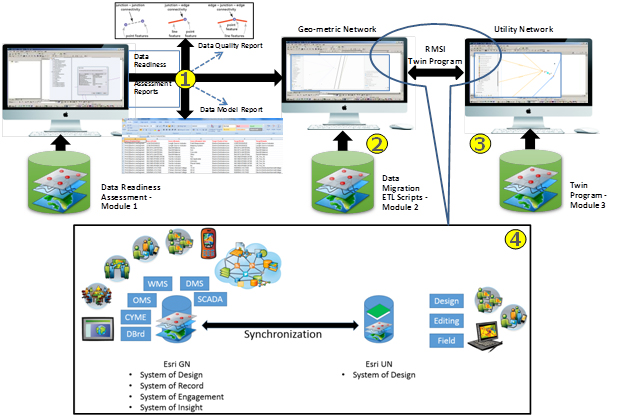
One of the advantages of participating at a global conference is the opportunity to compare the range of market offerings. At GeoConX 2018, the hot topic was the Utility Network (UN). Attendees were searching for differentiators while they evaluated their options. The UN provides powerful advancements, but it also entails significant investment, so differentiators are VERY important. I will come back to this and the Twin in a moment.
In my previous UN blog, I described the UNDT program’s two-part readiness assessment. If you recall, the assessment analyzes your data to determine how ready you are to migrate to the UN. Using that data, you can plan out an improvement program. Once you have evaluated your readiness, it is time to move onto the second part of the process, migrating your data from the geometric network (GN).
Normally, organizations planning a data migration consider the style that’s most suited to their needs. While you can choose from several strategies, depending on the project requirements and available processing windows, it often boils down to two fundamental types: big bang migrations or trickle migrations. Unfortunately, a UN migration isn’t suited to either on its own.
Consider the following:
- First, the data improvement program you created from the readiness assessment will take time and you may want to complete it in the existing GN
- Second, while technology is driving the migration, it is developing slowly. It will take time before some components are available to address all your goals (for example, vertical integration)
- Third, you may need the market to evolve. Your GN may have many point to point integrations, and some of your systems may not be able to work with a services based model. You need time for other technologies to mature and address these technical mismatches
- Fourth, the migration will cost money. Unless you are planning a supplemental rate case, you will have to use planned capital investments and an existing expense driven program to deliver part of the work. This work may need to be spread over several years
- Fifth, the data you are migrating is the underpinning of your company and downtime or inaccuracies will have ramifications on safety and emergency preparedness. You need to mitigate the risk associated with the UN migration
So, what does this mean? You need flexibility. You need a current GN database capable of facilitating operations which also allows business processes to migrate at their own pace. You need a long migration period, so that you can minimize program costs through existing enterprise upgrade and enhancement plans. Lastly, you need to ensure that there is no disruption to operations. Does this sound like I want to have my cake and eat it too? Nope, que the UN’s best friend “The Twin”.
To achieve these goals, we propose a blended migration model that we have named “The Twin”. Let me explain how it works.
First, a big bang migration is performed including all the traditional steps. We create a map between the models, design and develop the necessary ETL scripts, establish processes required to migrate variable data, identify areas where data will require manual involvement (for example stations), and create migration quality assessment reports. When you’re ready, you turn the crank and complete the migration. What is the result? You made a twin of your data in the UN; you created “Twin” data models.
Second, you take the ETL scripts created to perform the migration and use them to create a bidirectional synchronization. This synchronization is used for the second part of the migration, a trickle. This trickles content changes between models as business processes are migrated from the GN to the UN. There you have it, “The Twin”.
The Twin allows a utility to define their own schedule/plan for migrating business functions and creating UN – operational system integrations (ADMS, OMS, WMS etc.). During the transition period, you simply continue to use your existing environment, solutions and integrations. “The Twin” remains in place until all aspects of the migration are complete.
Remember that need for stability and risk mitigation? Safety and operational programs only start using data feeds from the UN when you feel it is ready, after it has been properly tested, and retested, not because of a migration driven cut over.
I always find I understand things better through images so below is a diagram of our “UNDT” solution including:
- The data readiness assessment
- ETL scripts to migrate GN data into the UN.
- Bidirectional syncing between GN and the UN.
- The expanded box gives an example of how a utility has chosen to start their migration. This utility has started with the “system of design” as the first process they migrated. In the UNDT, you choose the migration order based on your business needs. When this client completed the migration, all solutions would have moved from the right to the left.

Let’s circle back to where we started. Remember I mentioned differentiators? We discovered some for the Twin at GeoConX:
- The data readiness assessment: No requirement of a costly workshop. The evaluation is automated allowing you to run it regularly and assess the impact of your data updating or improvement processes. You can assess data improvement initiatives based on your results.
- Migration approach: While many organizations offer a synchronization process, “The Twin” is the only bidirectional one. While this is difficult, it is essential if you plan to slowly move business processes from the GN to the UN.
In our next UN blog on this topic, we are going to change gears and move away from technology. Erik Shepard and I are going to discuss some of the business cases that you can use to justify your UN migration. As always, if you have any questions, contact me directly at robert.brook@rmsi.com.